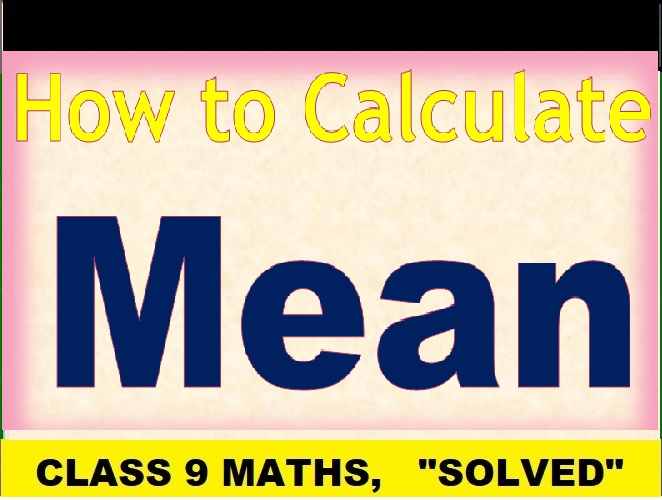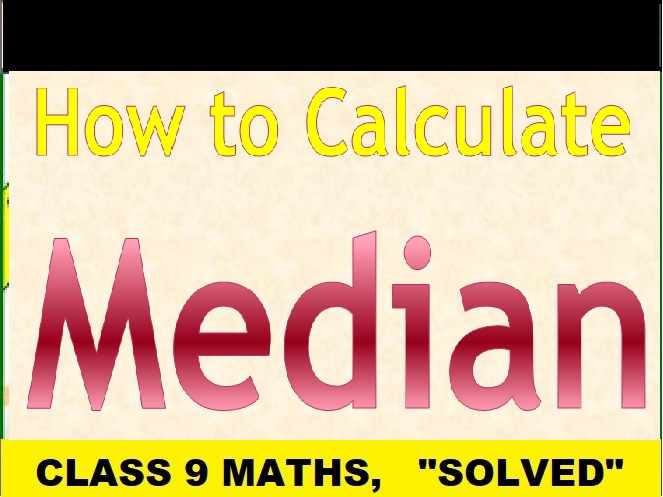Structure of Chromosome Part-B Long and structured Questions Class-10 Goyal Brothers ICSE Biology Solutions Ch-2. We Provide Solutions of Long Answer Type Questions and Structured Type Questions of Exercise-2 Structure of Chromosomes. Visit official Website CISCE for detail information about ICSE Board Class-10 Biology.
Structure of Chromosome Part-B Long and Structured Questions
Class-10 Goyal Brothers ICSE Biology Solutions Ch-2
| Board | ICSE |
| Publications | Goyal Brothers publications |
| Subject | Biology |
| Class | 10th |
| Writer | Dr. K.K. Aggrawal |
| Chapter-2 | Structure of Chromosomes Part-B |
| Topics | Solutions of Long Answer Type Questions and Structured Questions |
| Edition | for 2022-2023 Academic Session |
Note :- Before Viewing Goyal Brothers Solutions of Chapter-2 Part-B Structure of Chromosomes. Read the whole chapter carefully with figure. Make a self written notes including Phases of Mitosis.
D. LONG ANSWER TYPE QUESTIONS
Ch-2 Part-B Structure of Chromosomes Goyal Brothers Prakashan ICSE Class-10 Biology Solutions
(Page-28)
Question 1: What are nucleosomes? Draw the structure of one nucleosome along with DNA strand.
Answer : A nucleosome is a section of DNA that is wrapped around a core of proteins. Inside the nucleus, DNA forms a complex with proteins called chromatin, which allows the DNA to be condensed into a smaller volume. When the chromatin is extended and viewed under a microscope, the structure resembles beads on a string
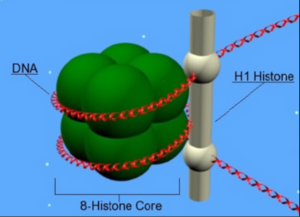
Question 2: Explain the structure of a chromosome.
Answer :
The chromosome is the condensed and compactly arranged structure of the DNA with the help of histone proteins H1, H2A, H2B, H3 and H4. This is the structure which can be visible during the metaphase of cell division. This condensed packing allows the long DNA in the eukaryotes to be packed in the nucleus of the cell.
Question 3: Mention the changes you observe in the structure of chromosomes in different stages of cell cycle.
Answer :
Interphase: In interphase, cells grow in size and volume and prepare for the next cell division. It is divided into three phases:
- First growth phase (G1):RNA and proteins are synthesised, and the volume of the cytoplasm increases.
- Synthesis phase (S):DNA is synthesised and chromosomes are duplicated.
- Second growth phase (G2):RNA and proteins continue to be synthesised.
Mitosis:
Mitosis is the division of somatic cells in which two identical daughter cells are produced by the division of one parent cell.
It consists of the following phases:
- Karyokinesis: It is the division of the nucleus during cell division.
- Cytokinesis: It is the division of the cytoplasm during cell division.
Karyokinesis:
It occurs in four phases:
- Prophase: During prophase, chromatinfibres condense and thick chromosomes are visible. The nucleolus and nuclear membrane disappear. A pair of centrioles duplicates. The spindle apparatus starts forming.
- Metaphase: Chromosomes are arranged on the metaphase plate or equatorial plane.
- Anaphase: The centromere divides, and the sister chromatids separate from each other. Spindlefibres contract and pull chromatids towards opposite poles.
- Telophase: Spindle apparatus disappears. Chromosomes become thin and turn into chromatinfibres. Nuclear membranes and nucleoli reappear.
Question 4: State the importance of chromosomes.
Answer : Chromosomes are very important because they contain vast majority of genetic information of organism. The organism’s DNA is contained within the chromosome as a long series of nucleotides thar are organised into genes. And helps to inherit the characters of parents to their offsprings
E. STRUCTURED QUESTIONS
Part-B Ch-2 Cell cycle and Cell Division Goyal Brothers Prakashan ICSE Class-10 Biology Solutions
(Page-28)
Question 1: Look at the given figure and write the name of each part (a) to (d) :
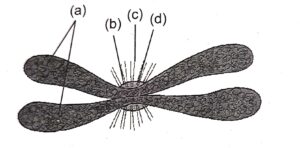
Answer :
a. chromatid
b. centromere
c. spindle microtubule
d. kinetochore
Question 2: Give the correct sequence of the process of DNA replication :
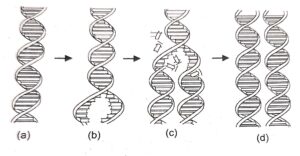
Answer :
correct order is = a, b ,c, d
Question 3: Look at the given diagram and answer the questions followed :
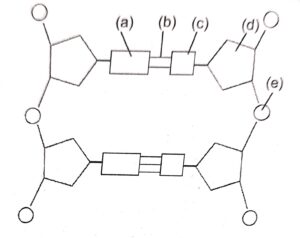
(i) Name the parts labelled as (a), (b), (c), (d) and (e).
(ii) Name the possible combinations of nitrogenous bases.
Answer :
(i) (a)= base, (b)= hydrogen bond, (c) = base , (d)= sugar and (e) = phosphate
(ii) the possible combinations of nitrogenous bases
- Guanine and adenine are double-ringed purine molecules.
- Cytosine, thymine and uracil are single-ringed pyrimidine molecules
Question 4: Given below is a diagram of a double helical structure of DNA :
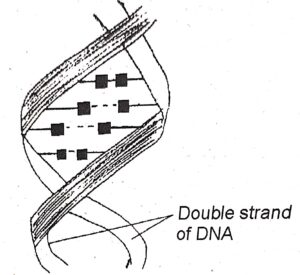
(i) Name the four nitrogenous bases that from a DNA molecule.
(ii) Give the full form of DNA.
(iii) Name the unit of heredity.
(iv) Mentions two points of differences between mitosis and meiosis.
Answer :
(i) Adenine, Guanine, Cytocine, Thymine
(ii) De-oxy Ribosenucleic Acid.
(iii) Genes.
(iv)
| Mitosis | Meiosis |
| (1) Occurs in somatic cells. | (1) Occurs in reproductive cells. |
| (2) Produces two daughter cells. | (2) Produces four daughter cells |
— : End of Structure of Chromosome Part-B Long and structured Questions Solutions :–
Return to :- ICSE Biology for Class 10 Goyal Brothers Prakashan solutions
